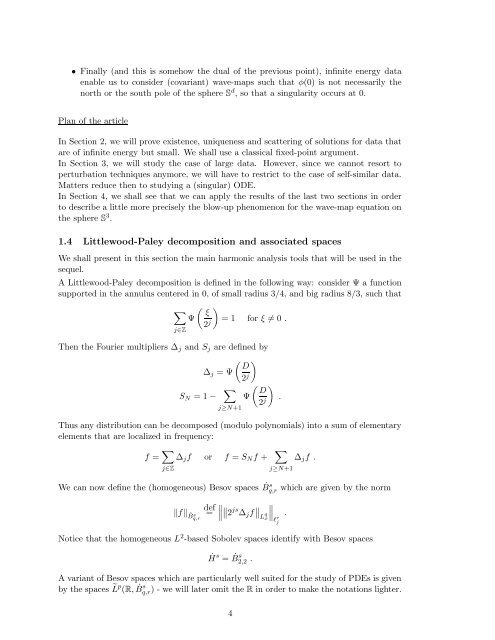Besov spaces and self-similar solutions for the wave-map equation
Besov spaces and self-similar solutions for the wave-map equation
Besov spaces and self-similar solutions for the wave-map equation
Create successful ePaper yourself
Turn your PDF publications into a flip-book with our unique Google optimized e-Paper software.
• Finally (<strong>and</strong> this is somehow <strong>the</strong> dual of <strong>the</strong> previous point), infinite energy data<br />
enable us to consider (covariant) <strong>wave</strong>-<strong>map</strong>s such that φ(0) is not necessarily <strong>the</strong><br />
north or <strong>the</strong> south pole of <strong>the</strong> sphere S d , so that a singularity occurs at 0.<br />
Plan of <strong>the</strong> article<br />
In Section 2, we will prove existence, uniqueness <strong>and</strong> scattering of <strong>solutions</strong> <strong>for</strong> data that<br />
are of infinite energy but small. We shall use a classical fixed-point argument.<br />
In Section 3, we will study <strong>the</strong> case of large data. However, since we cannot resort to<br />
perturbation techniques anymore, we will have to restrict to <strong>the</strong> case of <strong>self</strong>-<strong>similar</strong> data.<br />
Matters reduce <strong>the</strong>n to studying a (singular) ODE.<br />
In Section 4, we shall see that we can apply <strong>the</strong> results of <strong>the</strong> last two sections in order<br />
to describe a little more precisely <strong>the</strong> blow-up phenomenon <strong>for</strong> <strong>the</strong> <strong>wave</strong>-<strong>map</strong> <strong>equation</strong> on<br />
<strong>the</strong> sphere S 3 .<br />
1.4 Littlewood-Paley decomposition <strong>and</strong> associated <strong>spaces</strong><br />
We shall present in this section <strong>the</strong> main harmonic analysis tools that will be used in <strong>the</strong><br />
sequel.<br />
A Littlewood-Paley decomposition is defined in <strong>the</strong> following way: consider Ψ a function<br />
supported in <strong>the</strong> annulus centered in 0, of small radius 3/4, <strong>and</strong> big radius 8/3, such that<br />
<br />
<br />
ξ<br />
Ψ<br />
2j <br />
= 1 <strong>for</strong> ξ = 0 .<br />
j∈Z<br />
Then <strong>the</strong> Fourier multipliers ∆j <strong>and</strong> Sj are defined by<br />
<br />
D<br />
∆j = Ψ<br />
2j <br />
SN = 1 − <br />
<br />
D<br />
Ψ<br />
2j <br />
j≥N+1<br />
Thus any distribution can be decomposed (modulo polynomials) into a sum of elementary<br />
elements that are localized in frequency:<br />
f = <br />
∆jf or f = SNf + <br />
∆jf .<br />
j∈Z<br />
We can now define <strong>the</strong> (homogeneous) <strong>Besov</strong> <strong>spaces</strong> ˙ B s q,r<br />
f ˙ B s q,r<br />
def<br />
=<br />
<br />
<br />
2 js ∆jf q<br />
L <br />
x ℓr j<br />
.<br />
j≥N+1<br />
<br />
<br />
which are given by <strong>the</strong> norm<br />
Notice that <strong>the</strong> homogeneous L 2 -based Sobolev <strong>spaces</strong> identify with <strong>Besov</strong> <strong>spaces</strong><br />
˙H s = ˙ B s 2,2 .<br />
A variant of <strong>Besov</strong> <strong>spaces</strong> which are particularly well suited <strong>for</strong> <strong>the</strong> study of PDEs is given<br />
by <strong>the</strong> <strong>spaces</strong> L p (R, ˙ B s q,r ) - we will later omit <strong>the</strong> R in order to make <strong>the</strong> notations lighter.<br />
4<br />
.
















